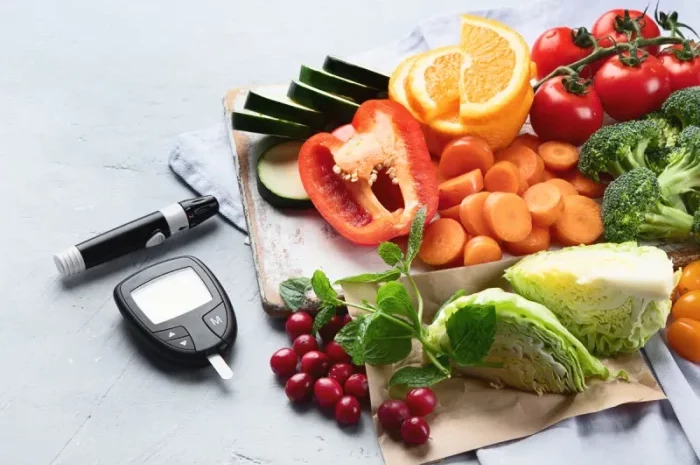Managing diabetes effectively requires a thorough understanding of the impact of diet on blood sugar levels. The right dietary choices can help maintain stable blood sugar levels, support overall health, and prevent complications associated with diabetes. This article delves into the recommended foods for diabetics, providing detailed insights into their benefits and how they can be incorporated into a balanced diet.
Understanding Diabetes and Dietary Needs
Diabetes is a chronic condition characterized by high blood sugar levels due to the body’s inability to produce or effectively use insulin. There are three main types of diabetes: Type 1, Type 2, and gestational diabetes. Each type requires careful management of blood sugar levels, primarily through diet, exercise, and medication.
Diet plays a crucial role in managing diabetes. The goal is to consume foods that help regulate blood sugar levels, provide essential nutrients, and promote overall health. A balanced diabetic diet includes a variety of foods from all food groups, emphasizing whole grains, lean proteins, healthy fats, and a plethora of fruits and vegetables.
The Role of Carbohydrates in a Diabetic Diet
Carbohydrates have the most significant impact on blood sugar levels. Therefore, managing carbohydrate intake is vital for diabetics. Not all carbohydrates are created equal; some cause rapid spikes in blood sugar, while others are absorbed more slowly, leading to gradual increases in blood sugar levels.
Whole Grains: Whole grains are a superior choice for diabetics compared to refined grains. They are rich in fiber, which slows down the digestion and absorption of carbohydrates, leading to more stable blood sugar levels. Recommended whole grains include:
- Oats: Rich in soluble fiber, oats help control blood sugar levels and improve heart health.
- Quinoa: A complete protein source, quinoa is also high in fiber and has a low glycemic index.
- Brown Rice: Unlike white rice, brown rice retains its bran and germ, providing more fiber, vitamins, and minerals.
- Barley: High in beta-glucan, barley helps lower blood sugar and cholesterol levels.
Legumes: Beans, lentils, and chickpeas are excellent sources of complex carbohydrates, protein, and fiber. They have a low glycemic index and help maintain stable blood sugar levels. Examples include:
- Black Beans: Packed with fiber and protein, black beans help regulate blood sugar and promote satiety.
- Lentils: Versatile and nutritious, lentils are high in fiber, protein, and essential minerals like iron and magnesium.
- Chickpeas: Known for their versatility, chickpeas are rich in fiber, protein, and essential nutrients.
Non-Starchy Vegetables: Non-starchy vegetables are low in carbohydrates and calories, making them ideal for diabetics. They are rich in vitamins, minerals, and fiber, contributing to overall health and blood sugar management. Examples include:
- Leafy Greens: Spinach, kale, and Swiss chard are nutrient-dense and low in carbohydrates.
- Cruciferous Vegetables: Broccoli, cauliflower, and Brussels sprouts are high in fiber and vitamins.
- Bell Peppers: Low in calories and high in vitamins A and C, bell peppers are a great addition to a diabetic diet.
Importance of Protein in a Diabetic Diet
Protein is essential for building and repairing tissues, and it helps regulate blood sugar levels by slowing the absorption of carbohydrates. Diabetics should focus on lean protein sources to maintain a healthy weight and reduce the risk of cardiovascular diseases.
Lean Meats and Poultry: Opt for skinless poultry, lean cuts of beef, pork, and lamb to reduce saturated fat intake. Examples include:
- Chicken Breast: High in protein and low in fat, chicken breast is a versatile and healthy choice.
- Turkey: Similar to chicken, turkey is low in fat and rich in protein.
- Lean Beef: Cuts like sirloin and tenderloin are lower in fat and suitable for a diabetic diet.
Fish and Seafood: Rich in omega-3 fatty acids, fish and seafood support heart health and help reduce inflammation. Recommended options include:
- Salmon: High in omega-3 fatty acids, salmon helps lower triglyceride levels and improve heart health.
- Mackerel: Another fatty fish rich in omega-3s, mackerel is beneficial for heart health.
- Shrimp: Low in calories and high in protein, shrimp is a good option for a diabetic diet.
Plant-Based Proteins: Plant-based proteins are excellent for diabetics, offering additional fiber and nutrients. Examples include:
- Tofu: A versatile protein source, tofu is low in carbohydrates and can be used in various dishes.
- Tempeh: Made from fermented soybeans, tempeh is high in protein, fiber, and probiotics.
- Edamame: Young soybeans, edamame is rich in protein, fiber, and essential nutrients.
The Role of Healthy Fats
Healthy fats are essential for overall health and can help regulate blood sugar levels. Diabetics should focus on unsaturated fats, which support heart health and reduce inflammation.
Monounsaturated Fats: Found in various plant-based oils, nuts, and seeds, monounsaturated fats help improve blood sugar control and reduce cholesterol levels. Examples include:
- Olive Oil: Rich in monounsaturated fats, olive oil supports heart health and can be used in cooking and dressings.
- Avocado: High in healthy fats, fiber, and essential nutrients, avocado is a versatile addition to a diabetic diet.
- Nuts and Seeds: Almonds, walnuts, chia seeds, and flaxseeds provide healthy fats, fiber, and protein.
Polyunsaturated Fats: These fats, including omega-3 and omega-6 fatty acids, are essential for brain function and cell growth. Examples include:
- Fatty Fish: Salmon, mackerel, and sardines are rich in omega-3 fatty acids, which support heart health.
- Walnuts: High in omega-3s, walnuts are a nutritious snack option for diabetics.
- Chia Seeds: Packed with fiber and omega-3s, chia seeds can be added to smoothies, yogurt, and salads.
Fruits and Diabetes
Fruits provide essential vitamins, minerals, and fiber, but they also contain natural sugars. Diabetics should choose fruits with a low glycemic index and monitor portion sizes to manage blood sugar levels effectively.
Berries: Berries are low in sugar and high in fiber, antioxidants, and essential nutrients. Examples include:
- Blueberries: Rich in antioxidants and vitamins, blueberries help improve insulin sensitivity.
- Strawberries: Low in sugar and high in fiber, strawberries are a delicious and nutritious choice.
- Raspberries: High in fiber and antioxidants, raspberries help regulate blood sugar levels.
Citrus Fruits: Citrus fruits are high in vitamin C, fiber, and antioxidants, supporting immune health and blood sugar control. Examples include:
- Oranges: While they contain natural sugars, oranges are high in fiber and vitamin C.
- Grapefruit: Known for its low glycemic index, grapefruit helps regulate blood sugar levels.
- Lemons: Low in sugar and high in vitamin C, lemons can be used to flavor foods and beverages.
Apples: High in fiber and vitamins, apples are a good choice for diabetics when consumed in moderation. They can help regulate blood sugar levels and provide essential nutrients.
Dairy and Diabetes
Dairy products provide calcium, protein, and essential vitamins. However, some dairy products can be high in fat and sugar. Diabetics should choose low-fat or fat-free options to manage their blood sugar and cholesterol levels.
Greek Yogurt: High in protein and probiotics, Greek yogurt supports gut health and helps regulate blood sugar levels. Opt for plain, unsweetened varieties to avoid added sugars.
Cottage Cheese: Low in fat and high in protein, cottage cheese is a nutritious option for diabetics. It can be paired with fruits or vegetables for a balanced snack.
Milk: Choose low-fat or fat-free milk to reduce saturated fat intake. Almond milk, soy milk, and other plant-based milk alternatives can also be good options, provided they are unsweetened and fortified with essential nutrients.
The Importance of Fiber
Fiber is crucial for diabetics as it slows down the absorption of sugar and helps regulate blood sugar levels. There are two types of fiber: soluble and insoluble. Both types are important for overall health and should be included in a diabetic diet.
Soluble Fiber: This type of fiber dissolves in water and forms a gel-like substance, slowing down digestion and helping control blood sugar levels. Sources of soluble fiber include:
- Oats: Rich in beta-glucan, oats help lower blood sugar and cholesterol levels.
- Beans: Black beans, lentils, and chickpeas are high in soluble fiber and protein.
- Fruits: Apples, berries, and citrus fruits provide soluble fiber and essential nutrients.
Insoluble Fiber: This type of fiber does not dissolve in water and helps add bulk to the stool, promoting regular bowel movements. Sources of insoluble fiber include:
- Whole Grains: Brown rice, barley, and whole wheat provide insoluble fiber and essential nutrients.
- Vegetables: Leafy greens, broccoli, and bell peppers are high in insoluble fiber and vitamins.
- Nuts and Seeds: Almonds, flaxseeds, and chia seeds provide insoluble fiber and healthy fats.
Managing Portion Sizes and Meal Timing
In addition to choosing the right foods, managing portion sizes and meal timing is essential for diabetics. Eating smaller, more frequent meals can help maintain stable blood sugar levels throughout the day.
Portion Control: Measuring portions and being mindful of serving sizes can help prevent overeating and blood sugar spikes. Using smaller plates and bowls, reading food labels, and tracking food intake are effective strategies for managing portion sizes.
Balanced Meals: Each meal should include a balance of carbohydrates, protein, and healthy fats to promote stable blood sugar levels. The plate method is a useful tool for creating balanced meals:
- Fill half of the plate with non-starchy vegetables.
- Fill one-quarter of the plate with lean protein.
- Fill one-quarter of the plate with whole grains or starchy vegetables.
- Include a serving of fruit and a source of healthy fat.
Regular Meal Timing: Eating at consistent times each day helps regulate blood sugar levels. Diabetics should aim to eat three main meals and two to three snacks at regular intervals to prevent blood sugar fluctuations.
Hydration and Diabetes
Staying hydrated is important for everyone, but especially for diabetics. Proper hydration helps maintain blood sugar levels and supports overall health.
Water: Water is the best choice for hydration as it does not contain calories or carbohydrates. Drinking enough water throughout the day helps flush out toxins and regulate blood sugar levels.
Herbal Teas: Unsweetened herbal teas are a good alternative to sugary beverages. Options like chamomile, peppermint, and green tea provide antioxidants and can be enjoyed hot or cold.
Limit Sugary Beverages: Diabetics should avoid sugary drinks like soda, fruit juices, and sweetened teas as they can cause rapid spikes in blood sugar levels. Opt for water, herbal teas, or infused water with a splash of lemon or cucumber.
Special Considerations for Diabetic Diets
While the above guidelines provide a foundation for a diabetic diet, individual needs and preferences may vary. It is important for diabetics to work with healthcare professionals, such as dietitians and diabetes educators, to create a personalized meal plan that meets their specific needs.
Personalized Meal Plans: A registered dietitian can help diabetics create a meal plan tailored to their individual health goals, lifestyle, and preferences. This plan may include specific recommendations for carbohydrate intake, portion sizes, and meal timing.
Monitoring Blood Sugar Levels: Regular monitoring of blood sugar levels is crucial for diabetics to understand how different foods affect their blood sugar. This information can help guide dietary choices and adjustments to the meal plan.
Physical Activity: Incorporating regular physical activity into the daily routine is important for managing diabetes. Exercise helps improve insulin sensitivity, regulate blood sugar levels, and support overall health. Diabetics should aim for at least 150 minutes of moderate-intensity exercise per week, such as walking, swimming, or cycling.
Conclusion
A balanced diet is essential for managing diabetes and maintaining overall health. By choosing the right foods, controlling portion sizes, and eating at regular intervals, diabetics can achieve stable blood sugar levels and reduce the risk of complications. Whole grains, lean proteins, healthy fats, non-starchy vegetables, and low-glycemic fruits should form the foundation of a diabetic diet. Additionally, staying hydrated and incorporating regular physical activity are crucial components of diabetes management. Working with healthcare professionals to create a personalized meal plan can further support diabetics in achieving their health goals and improving their quality of life.

























